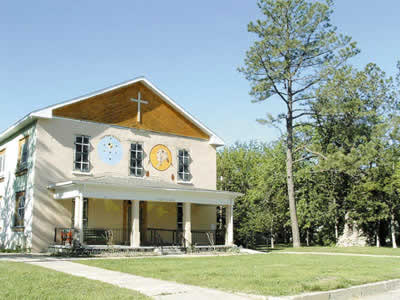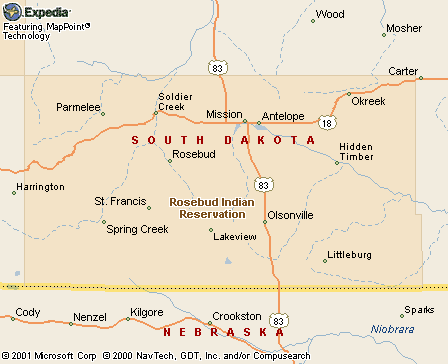|
|
Canku Ota |
|
|
(Many Paths) |
||
|
An Online Newsletter Celebrating Native America |
||
|
June 19, 2004 - Issue 115 |
||
|
|
||
|
Rosebud Youth Learn Tradition Through Basic Education |
||
|
by David Melmer / Indian Country Today |
||
|
credits: This dormitory center is part of a building remaining from the St. Francis Mission on the Rosebud. This building is still in use, although the school is no longer part of the mission. (Photo by David Melmer) |
|
Non-Indian influences, racism, poverty, and unequal treatment in school all impair the learning process for the Sicangu, Cynthia Young, director of education for the Rosebud Sioux Tribe said. To the Lakota, the language and culture take center stage to help youth know who they are so they can take pride in their traditions and participate in the learning process without intimidation. The tribal education department tracks students’ progress and resolve problems whether in public or tribal schools. The rewards for graduation are monetary for students on or off the reservation. Each graduating senior gets $100 and eighth graders receive $50. The Sicangu contract one school on the reservation at St. Francis, a former catholic mission boarding school. The others are public schools with a majority of Lakota students and mostly non-Indian teachers and administration. Middle age and elder tribal members have a mixed reaction to their past education experiences at St. Francis. The Lakota language was outlawed and the intent was to force assimilation of the culture into the white world. "I was 16-years-old when I went to St. Francis Mission. All my peers ridiculed me because I spoke my language. I barely spoke English," said Albert White Hat, language and cultural instructor at Sinte Gleska University. "We were ridiculed for being Indian, and these were all Indian kids. Many years later I found out they had been in that institution since they were 5, so by the time they were 12 years old they had already been conditioned to deny their Indianness and ridicule it." Cultural education and Lakota language classes become core curriculum courses at Sinte Gleska University, the tribal university. Many of the students have little grasp of the language and know little of the culture. Education has become more of an issue with a reservation that has 51 - 52 percent of the population under the age of 21 and growing. This is creating a burden on the K - 12 schools. And at the same time, Young said, when funding is essential the Bush administration is cutting funds to Indian education. An especially difficult situation is the drop out and truancy rates at the K - 12 level, which is improving. Many parents with a less-than-positive attitude toward education are not strongly involved with their children’s education. Poverty and cultural beliefs also lead to reduced attendance at times. "There are few family advocates and parent support. People lack money and don’t have the things others do, they can’t buy designer tennis shoes so they are embarrassed to attend school," Young said. The tribe awards each child $100 for clothing at the beginning of the school year. That amount doesn’t go far when the designer tennis shoes cost at least that much. Nevertheless, the future on the Rosebud is brightening. Education forums are under way to bring parents and students together to listen and offer concerns and discover solutions. And parent involvement in the schools is growing, Young said. It does go back to economics. Some parents who are not involved use most of their energy to just take care of themselves, it’s an issue of survival. The forums deal with those issues and others, such as curfew, gangs, teachers and administrators that may be taking sides. "The parents want the kids educated. And if the No Child Left Behind Act was interpreted right it would help," Young said. Funding for more family advocates is necessary for the Rosebud education program. The tribe does fund the program, but it also has other programs under its control that need attention and the tribal coffers are not exactly overflowing. Rosebud Casino net revenues go to the tribe, but it is not enough. The education department’s goal is to hire more family advocates and also to put counselors in each school. Another problem; qualified and certified teachers are hard to find in remote areas of South Dakota, especially on the reservations. The teachers must know both worlds, Young said. A proposal is to turn part of the St. Francis School into a demonstration school, or alternative school, where science and math are taught using the environment, it’s called outdoor math and science. The language and culture would also be core elements of the curriculum. The Native American Rights Fund is funding the development of an education code updating, yet enforcement is the key, Young said. "If it is enforced it will make all educators accountable." New thinking for troubled youth A new facility called the Rosebud Wellness and Renewal Center will provide safe housing and education for youth who are adjudicated to detention. The facility, according to Patricia Broken Leg Brill, facility administrator, is not to be thought of as a detention center. The philosophy of the organization is to partner with health education, alcohol treatment, academics and culture. Part of the facility will be for "day report" where youth will attend during the day and spend their nights at home or in another facility. Another part is for incarceration, but those youth will also be treated to education and rehabilitation. What the youth do in the facility is only part of the equation. What happened before and what will happen after the person is released is important in the step to after-care and will set the stage for rehabilitation, Broken Leg Brill said. "It will provide all components, through a cultural approach. We will use the environment surrounding them and program along the cultural line." One aspect of the rehabilitation will be an equine therapy program. Horses were important to the Lakota people and this fits into the cultural development. Environmental issues through landscaping and learning about nature and trees will teach care and responsibility and additional skills to the youth. "We can’t just house them and let them go, after-care is important. If we don’t follow up and provide good decision-making skills they will be back," Broken Leg Brill said. "We want to reconnect families, provide for a good extended family. This will set the stage for teaching kinship," she said The process for the rethinking of youth detention came about because of a high rate of crime and violence on the reservation. Many people on the reservation knew that past policies of detention were not working so they decided to build their own facility with a new philosophy. "The thought was how to take the cultural ways and weave them into modern thinking and take care of our own. It was a challenge to bring the old ways into new thinking. We had the elders, law enforcement and other key people on the committee," Broken Leg Brill said. The symbols of the Lakota are visible throughout the facility; there is a spiritual room in the middle where ceremonies with spiritual leaders will be held. "The four directions and four colors are in circular areas, they will always keep us in constant thought of Lakota culture," she said. The facility can accommodate 87 youth and contracts will be made between other tribes and the state. Twenty staff members who are trained by the Indian Police Academy in Artesian, N.M. will supervise the youth. One plan is to also train staff at Rosebud to reduce the cost. This is a state-of-the-art facility, it is heated with a geothermal system and has its own waste water treatment plant. It is not the average facility, Broken Leg Brill said. The cost was $8.9 million, of which the tribe contributed 10 percent and a Department of Justice Grant contributed 90 percent. In October 2003 the BIA office of Law Enforcement named the Rosebud center a model facility. There is room for 40 day-report youth that will be educated by the St. Francis Tribal School and be brought in daily by their families. Also, 36 males and females will be housed in the facility. They will eventually be filtered through the day-report facility. There are also 11 cells for other youth. Seventy percent of the building is designated for cultural, education, spiritual and counseling with eight classrooms, a library, an arts and crafts space and a computer room. An indoor gymnasium is also provided. Attention was also given to the colors of the interior; therapeutic greens, purples and light lavenders. Youth on the reservation were involved in the design, and development of the philosophy. "We wanted to get rid of the stereotype of what jails were like. We will stick to our plan of rehabilitation and the connected family to help provide a secure environment," Broken Leg Brill said. |
|
|
www.expedia.com |
|
|
||
|
|
||
| Canku Ota is a free Newsletter celebrating Native America, its traditions and accomplishments . We do not provide subscriber or visitor names to anyone. Some articles presented in Canku Ota may contain copyright material. We have received appropriate permissions for republishing any articles. Material appearing here is distributed without profit or monetary gain to those who have expressed an interest. This is in accordance with Title 17 U.S.C. Section 107. | ||
|
Canku Ota is a copyright © 2000, 2001, 2002, 2003, 2004 of Vicki Barry and Paul Barry. |
||
 |
 |
|
|
The "Canku Ota - A Newsletter Celebrating Native America" web site and its design is the |
||
|
Copyright © 1999, 2000, 2001, 2002, 2003, 2004 of Paul C. Barry. |
||
|
All Rights Reserved. |
||
 It
is no secret that youth are the future of any community. The people
of Rosebud understand this and continue to work hard for their
children.
It
is no secret that youth are the future of any community. The people
of Rosebud understand this and continue to work hard for their
children. 